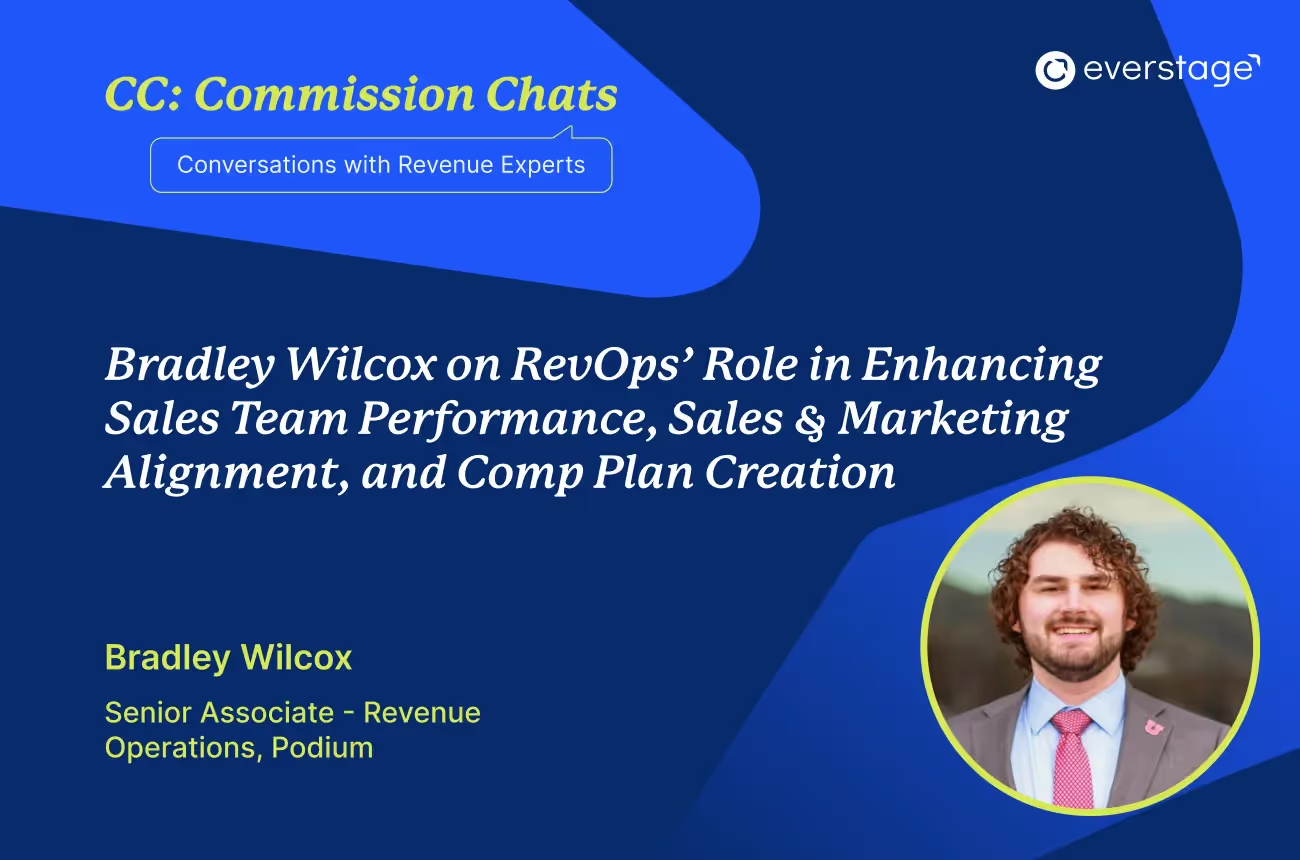Welcome to Everstage's ‘CC: Commission Chats’ – an interview series from Everstage featuring stories of world-class GTM leaders.
Martin Cepeda has been instrumental in scaling the go-to-market function at Instawork.
Starting out as an SDR and then moving into operations, Martin has over 3 years of experience in the sales operations / revenue operations domain.
In this exclusive interview, Martin discusses how to align RevOps strategies with overall business goals, how to leverage the power of technology, and the KPIs to measure success.
Let’s dive in!
How do you ensure your revenue operations strategies are aligned with the overall business goals and objectives?
That’s a great question. At Instawork, we use company-wide OKRs to set goals for each quarter, or the time period of your consideration. We set quarterly OKRs, which usually take a couple of weeks of preparation. During this time, we also meet with different cross-functional teams, such as sales, marketing, product - and get their inputs on the key drivers at the company.
Once the OKRs have been set, we have an internal brainstorming session on identifying the most important thing to work on for the quarter, which is aligned with the aforementioned OKRs. After this session, there’s another round with other key stakeholders, like VPs and Directors of Sales, to ensure alignment on the value for the particular type of project that we’re focusing on.
It’s a lot about making sure that we’re aligned with the overall vision of the company and what’s more important. We also ensure getting feedback from our different stakeholders. That’s essentially our alignment process.
What role does technology play in your revenue operations approach? Can you highlight any specific tools or platforms that have been instrumental in streamlining processes and improving revenue outcomes?
Technology is one of the most important factors for a strong sales team in general, and a strong RevOps team too. You often think of the classic CRM tools, like Salesforce and HubSpot. But we’ve seen a variety of tools recently that can give you a competitive edge.
We’ve adopted a wide set of go-to-market tech tools since I started at Instawork. Our tech stack includes Chili Piper for our AEs, SDRs, and AMs - to mitigate the operational pain of handing off demos, meetings, and onboardings. This has improved our process.
We also have LeanData for account distribution which is really important, because - and people who have worked with account distribution would know - it’s painful to set up territories, and then make manual updates on Salesforce and manage expectations across sales teams.
The third bucket of tools that we’re currently exploring and looking to integrate more closely with our tech stack is data enrichment and competitive intelligence. Currently, we use the standard ZoomInfo for contact polls for different companies or prospects.
But there’s also lead scoring tools like MadKudu and Dun & Bradstreet that we’ve adopted to help our sales reps get a better picture of the full funnel and the partners we’re trying to land. So, yes - technology is really important in our day-to-day and for our sales teams’ success. It’s certainly something that’s top of mind for us.
How do you define the role of Revenue Operations at Instawork, and how has it evolved since you started in February 2023? Can you share some specific examples of how you have contributed to scaling GTM (Go-to-Market) teams at Instawork?
I’ll tell you about our team structure at Instawork. Here, RevOps sits under BizOps. So we view BizOps as the analytical nerve center, connecting the different departments and ensuring alignment in the initiatives that we’re working on.
This means that sales should be speaking to marketing, marketing should be speaking to product - and everything should be in sync. The role of BizOps is to be the glue that connects different teams. For RevOps, it’s similar - we act as the glue for the go-to-market teams.
So, we work more closely with sales, marketing, and account management, making sure that the work we end up doing is strategic, long term thought partnership work. We also have the operational day-to-day work to do.
The longer term, strategic work might be looking at our sales strategy, or at which segments should we be doubling down - to act as the advisor to our business partners. And then the operational day-to-day work might consist of handling commission discrepancies or rectifying Salesforce errors - supporting the sales teams.
What's the structure and size of the sales team at Instawork, and how do you support that team on a daily basis?
The size of our team right now is hovering around 160-170, for our new business teams, i.e., our AEs and SDRs. I think the split is pretty even right now - it’s like 70-80 AEs and 70-80 SDRs.
Then we have SDR managers, directors, sales managers, and then VP of sales. And this is a headcount that we’ve scaled pretty aggressively since the start of 2023. I think when we started in 2023, we had around 80 people, and since then, we’ve doubled that, particularly in the SDR function. So it’s been really cool to see us grow in a short span of time.
What key performance indicators (KPIs) do you consider most essential in measuring the success of revenue operations, and how do you use them to drive decision-making?
Since BizOps and RevOps are more of a cross-functional partner to core teams like sales and marketing, a lot of our goals or KPIs are abstract from their success. While we use a variety of metrics, the one metric that we anchor on is: how well is our sales team or our account management team performing?
Thus we look at the count and the size of the partners we’ve been bringing in, like net new, but also the ones we’ve been retaining - are we bringing in the best partners that are possible, that are going to bring in the best revenue for the company? Are we keeping those partners around? I think that’s one.
But in terms of KPIs and how we use them to drive decision-making, or how we focus on things, it’s pretty simple. If we see a KPI, say we look at the sales funnel and observe our show rate or demo set rate to be pretty low. We go ahead and investigate this by partnering with our sales teams. We try to understand if this is an operational blocker, or a training opportunity for the team.
If we have the data that shows something is not really working out, we dig deeper, understand the drivers for it, and fix it by making improvements to the process.
How do you stay updated on the latest trends and advancements in revenue operations technology? Do you have any suggestions for our readers on what blogs to follow, podcasts to listen to, or people to follow to learn more about RevOps?
Interesting question, because revenue operations is still a relatively new field. We started out with pure Salesforce admin roles, then moved to more operational and analytical roles like sales operations and marketing operations. The idea of RevOps and GTMOps is still fairly new.
So, one thing I do is closely follow companies that have successful sales-led motions. I think of big, enterprise B2B companies like Snowflake, that have a standout achievement for setting the precedent on good sales motions. Anchoring to strong companies that are doing really well and are sales-led is one thing I do.
I also follow people who are leading the teams in those companies - like RevOps, Sales Ops, and sales. I ensure that I’m seeing what they’re posting, and try my best to learn from them.
The other thing I do is listen to podcasts and read newsletters by content creators who have been in this field for a long time now, and who have seen the industry evolve. Specific examples include Jeff Ignacio, who writes a wonderful Substack newsletter that’s just a treat to read. I’d definitely recommend his newsletter.
My final suggestion is a podcast by Kleiner Perkins called Grit, that talks to leading operators in the industry, particularly to companies who have achieved grand scale, for instance, Flexport or Notion. Speaking to their leading operators like CROs, COOs - who have structured their career and helped the company scale. It’s exciting to learn from these top operators not just on business growth, but also on the hard lessons they’ve learned along the way.


.avif)









